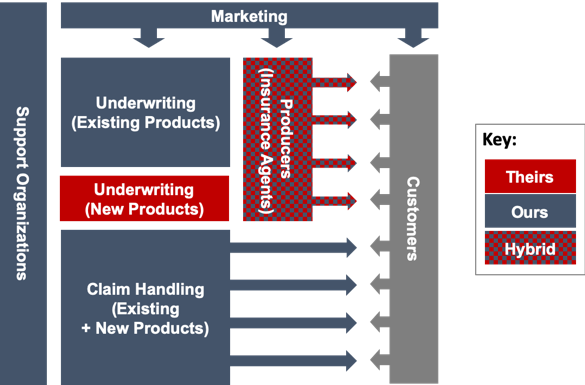You’ve likely seen alarming statistics regarding M&A deal failure rates, yet, for many companies, buying key capabilities to fit new strategic objectives is a quicker path than building these capabilities from scratch. Here are three powerful steps to setting up an acquisition for success.
Step 1: Clarify the Capability Mix
When your company is looking at an acquisition, there is an assumption that both organizations will bring capabilities to the table to benefit your customers, gain new customers, or perhaps improve the performance of the organization itself. As these capabilities are integrated, there are fundamentally only three broad options for each capability in the combined organization: “Theirs,” “Ours,” or “Hybrid.” It’s critical to go down the list of all capabilities and categorize the assumptions around which company’s capabilities will be used:
- Theirs – These capabilities directly add value to the newly-combined organization’s offerings. Though they are sometimes an efficiency play, these capabilities are often customer-facing or directly enable those customer-facing capabilities, and they help cause a customer to choose you over your competition.
- Ours – “Our” capabilities are those that must be preserved in order to maintain or improve the combined organization’s offerings or those that drive economies of scale. Typically, this includes much of the back-office work of the organizations.
- Hybrid – Beware of the seductive “hybrid” option, which occurs when your company wants to “get the best of both worlds” by combining the same capabilities of the two organizations. While this can work, you’re signing up for significant risks: Which capability is the starting point? Who will end up in leadership roles? What happens to the “losers?” Worse yet: You risk delivering a capability that’s worse than either company had before.
Step 2: Create a Visual Depiction of the Target Operating Model
A visual representation of the combined organization can help teams from both companies understand the strategic intent of the deal and how the acquired company’s capabilities fit into the big picture. The target operating model is a necessary foundation for all of the other design choices that need to be made and aligned: work processes, structure and governance, information and metrics, people and rewards, leadership and culture, and the continuous improvement systems of the organization (see Mastering the Cube).
Starting with the customers, show the interaction points with the combined organization’s capabilities, as well as how those connect back into the rest of the organization. Keep in mind that simple is good, and the target operating model should be as unique as your business. Here’s an example of a hypothetical acquisition of a new line of business by an insurance company:

Step 3: Develop Integration Plans Based on the Target Operating Model
After clarifying the new design, it’s time to bring the key players together to review the deal intent, go through the target operating model, and have the teams develop integration project plans. Regardless of how you approach this, it will be key to re-convene the teams to review plans in order to ensure strategic alignment and coordination across the teams, as well as make adjustments based on what the teams discover once they have begun working together.
Summary
While there are many other actions acquirers must take to ensure a successful integration, these three steps are an effective way to clarify the “how it will work” of the strategic intent, get teams aligned around a common vision, and develop and manage integration plans.





